 Hartlepool Sports & Leisure
Hartlepool Sports & Leisure
- Cinemas, Theatres & Dance Halls
- Musicians & Bands
- At the Seaside
- Parks & Gardens
- Caravans & Camping
- Sport
 Hartlepool Transport
Hartlepool Transport
- Airfields & Aircraft
- Railways
- Buses & Commercial Vehicles
- Cars & Motorbikes
- The Ferry
- Horse drawn vehicles
 A Potted History Of Hartlepool
A Potted History Of Hartlepool
- Unidentified images
- Sources of information
- Archaeology & Ancient History
- Local Government
- Printed Notices & Papers
- Aerial Photographs
- Events, Visitors & VIPs
 Hartlepool Trade & Industry
Hartlepool Trade & Industry
- Trade Fairs
- Local businesses
- Iron & Steel
- Shops & Shopping
- Fishing industry
- Farming & Rural Landscape
- Pubs, Clubs & Hotels
 Hartlepool Health & Education
Hartlepool Health & Education
- Schools & Colleges
- Hospitals & Workhouses
- Public Health & Utilities
- Ambulance Service
- Police Services
- Fire Services
 Hartlepool People
Hartlepool People
 Hartlepool Places
Hartlepool Places
 Hartlepool at War
Hartlepool at War
 Hartlepool Ships & Shipping
Hartlepool Ships & Shipping

Seaton Streets & Buildings
Details about Seaton Streets & Buildings
Street scenes and prominent buildings in Seaton Carew.
Location
Related items () :
 A bit of Old Seaton
A bit of Old Seaton
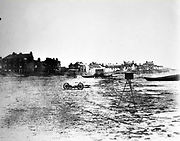 Created by Edward Backhouse
Donated by Bowes Museum, Barnard Castle, County Durham
Created by Edward Backhouse
Donated by Bowes Museum, Barnard Castle, County DurhamPart of the Part of the Pattison's Photograph Collection collection
Dated 1853
An early view of the village from the south. Note the bathing machines, boats, boat carriage and camera tripod on the beach. The photo was taken by Edward Backhouse who spent much of his time at Seaton.
More detail » Aerial view of Seaton Carew
Aerial view of Seaton Carew
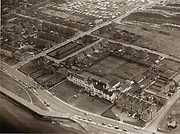 Donated by Hartlepool Library Service
Donated by Hartlepool Library ServiceA great view showing the Staincliffe with its rear tennis courts and the adjoining villas. Note the caravans on what is now a built up area.
More detail » Amusements and Southolme (1)
Amusements and Southolme (1)
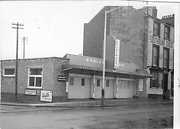 Donated by Hartlepool Library Services
Donated by Hartlepool Library ServicesPart of the Hartlepool Library collection
Dated 1962
Taken in 1962 snuggled against the Southolme Guest House is Nobles Amusements. Senior Service and Walls Ice Cream are advertised on the wall. Beside the door a sign reads that Ladies and Gents Toilets are within.
HHT&N 2015
More detail » Amusements and Southolme (2)
Amusements and Southolme (2)
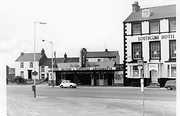 Donated by Hartlepool Library Services
Donated by Hartlepool Library ServicesPart of the Hartlepool Library collection
Probably taken in the late 1970s the Southolme is now called a hotel instead of a guest house. The amusements are now known as Las Vegas and boast the latest British and American Amusements.
More detail » Arch Hotel and Magic Shop
Arch Hotel and Magic Shop
 Donated by Hartlepool Library Services
Donated by Hartlepool Library ServicesPart of the Hartlepool Library collection
Dated 1981
By 1981 the Southolme had changed its name to the Arch Hotel. The Magic Shop next door was very popular selling all sorts of tricks, wigs, fancy dress costumes etc.
hht&n 1095
More detail » Ashburn Street (1)
Ashburn Street (1)
 Donated by Maureen Anderson
Donated by Maureen AndersonDated 1887
This image, which is about 1887, is looking toward 'Kirklea' in Church Street. Ashburn Street hosted a Temperance Hall and Reading Room, gifted by the Backhouse family, and the National School as well as residential dwellings and a brewery. The image may have been an early photo taken by James W Pattison.
More detail » Ashburn Street (2)
Ashburn Street (2)
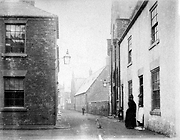 Donated by Maureen Anderson
Donated by Maureen AndersonDated 1887
Another view of about 1887 with the National School on the right of the image and Kirklea at the end. Possibly an early photo of James W Pattison's.
More detail » Ashburn Street (3)
Ashburn Street (3)
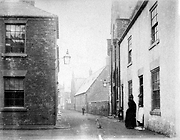 Donated by Maureen Anderson
Donated by Maureen AndersonDated 1887
Looking along Ashburn Street towards Church Street. The buiding next to the one outside where the little girl is standing is the Temperance Hall & further along is the National School. Note the dog in the middle of the road.
This photo was possibly taken by James W Pattison
More detail »
 Ashburn Street (4)
Ashburn Street (4)
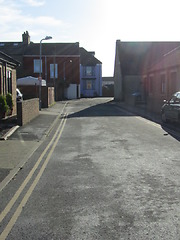 Created by Maureen Anderson
Donated by Maureen Anderson
Created by Maureen Anderson
Donated by Maureen AndersonDated 2012
In November 2012 nothing remains from the 19th century except 'Kirklea' at the end of the street. To the right of the image are elderly people's bungalows.
More detail » Bathing machines and boats
Bathing machines and boats
 Created by James Whitehead Pattison
Donated by Bowes Museum, Barnard Castle, County Durham
Created by James Whitehead Pattison
Donated by Bowes Museum, Barnard Castle, County DurhamPart of the Part of the Pattison's Photograph Collection collection
Dated 1888
Bathing machines on the sand no doubt waiting for those wishing to venture into the water! A group of men are talking while one man leans on a boat as another sits astride a horse.
Looking to the rear centre of the view the large house on the north corner of the Green is visible. Belonging to the Daniels family the house was later demolished.
More detail » Cafe Royal
Cafe Royal
 Donated by Hartlepool Library Service
Donated by Hartlepool Library ServiceDated 1978
The Cafe Royal at Seaton Carew, 1978. Originally a farmhouse it was built in the late 18th early 19th century.
More detail » Cafe Royal
Cafe Royal
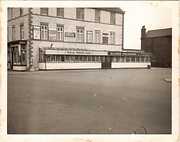 Donated by Hartlepool Library Services
Donated by Hartlepool Library ServicesPart of the Hartlepool Library collection
Dated 1962
The Cafe Royal in 1962. At this time it would have been a very busy shop selling ice cream, drinks etc. Most of the advertisments are smoking related such as Olivier tipped cigarettes and Capstan Full Strength.
HHT&N 1097
More detail » Cafe Royal
Cafe Royal
 Donated by Hartlepool Library Services
Donated by Hartlepool Library ServicesPart of the Hartlepool Library collection
Dated 1989
In 1989 owned by the Notarianni family and advertising Silk Cut cigarettes along the front of the awing.
HHT&N 1089
More detail » Cafe Royal
Cafe Royal
 Donated by Hartlepool Library Services
Donated by Hartlepool Library ServicesPart of the Hartlepool Library collection
This image of the Cafe Royal and the Rocket House would have possibly been taken around the 1940s judging by the cars in the scene. The wall of the 1938 bus station is visible on the left. The wall at the rear of the Cafe advertises Purifax Ice Cream.
HHT&N 1092
More detail » Carr House
Carr House
The name 'Carr' may have come for the Scandinavian for 'copse' so the meaning of the name would have been 'house in the copse'.
The Bishop of Durham gave lands to Merton College in Oxford when it was founded in 1264. Part of the land was the area around Carr House.
Before Mr William Thompson built Carr House in the 1820s there had been a previous Carr House on the same site. The original building had sometimes been known as Blue Houses because it had been roofed with blue tiles.
In 1709 part of a wreck had washed ashore at Carr House, another in 1727 and in 1729 a mast.
In 1766 the freeholder of Carr House was Robert Chilton.
Newcastle Courant February 21st 1795:
'To be sold by private contract, an eligible estate, called CARR HOUSE, in the Parish of Stranton and County of Durham containing 215 acres of land, or thereabouts, part freehold and part held by lease unders the Warders and Scholars of Morton College (Merton College), Oxford. Together with a house and an acre of land at Seaton and ten stints on the Snook and a right to three undivided fourth parts of one eighth part of and in the Manor of Seaton Carew. The farm-house and buildings are in good and convenient repair. The freehold pays a modus in lieu of tythes. N. Johnson (the tenant) will show the premises and for further particulars apply to Messrs Hopper, Attorney at Law, Durham. N.B. This will be no more advertised.'
The tenant was most likely Nicholas Johnson whose family had long been associated with Toft House (farm).
Known as both Carr House and Carr Houses by the drawings and photos that survive, it appears that there was either one very large building with the roofs at different levels or two attached buildings. Newspaper advertisements listed the property as two separate dwellings and name occupiers as a different family living in each of two properties. The exception is an advertisement of 1834 which advertises 'Half of Carr House.'
General Hue and Cry June 24th 1820:
SEA BATHING
'Two neat and commodious dwelling houses called CARR HOUSES situated on the sea banks within a quarter of a mile of Seaton Carew, and little more than a mile from Hartlepool, places much resorted to in the summer season by families of the first distinction, each containing a dining and drawing room, housekeeper's room, a good kitchen, pantry and six good lodging rooms with detached apartments for the menservants, large coach house and a seven stalled stable. A bathing machine upon the beach within 50 yards of the front door. The lodging commands a beautiful prospect of the Tees Bay, the Yorkshire Hills and places adjoining. A cow with hay, corn and grass, may be had if wanted.'
Durham Chronicle July 18th 1834:
SEA BATHING
'The Half of Carr House, near Seaton Carew
TO BE LET FOR SEA BATHING IMMEDIATELY.
THE UNOCCUPIED PART of the HOUSE contains a Dining and Drawing room, Kitchen, Cellar, Butler's Pantry, and Rooms for the convenience of Twelve Beds with a detached Kitchen if required; also a suitable Coach-house and Six-stalled Stable.'
Apply to Mr Wm Thompson, Dyke House, near Hartlepool.--Dyke House July 16th 1834.
William Thompson is mentioned as still having an interest in Carr Houses until he died in February 1851. From at least 1839 until his death in 1843 Edward Thomas Copely lived in one of the houses. John Stephenson, farmer, lived in one house from 1841, he died in 1873 aged 57. Henry Casebourne in the other from 1847 to 1887. Joseph Robinson is recorded as living in one of the houses from 1879 until at least 1887. William Bainbridge is recorded as having been a farmer there in 1914. Others that are mentioned as living at Carr House are S Barstow and James Perry.
In July 1887 a fire broke out in the cow-byre of Carr House farm. Robert Taylorson of West Hartlepool was passing at about midnight when he saw the flames. He woke Henry Casebourne's household and Joseph Robinson's family and then alerted PC Drow who in turn alerted the fire brigade. Between the two families and the fire brigade the fire was extinguished. A bull and a calf were injured. The fire had been caused by a tramp going into the building with a lighted pipe.
Over the years various people had lived in Carr House cottages which were many decades older than the 1820s built buildings. Many would have been farmhands or fishermen. Cornelious Hodgson was a fisherman who lived in one of the cottages. In 1897 his young son was killed when he was scalded with boiling water.
The cottages were condemned in 1900 when it was discovered that 35 people were living in them sharing only one water tap and two privies between them. The cottages were pulled down in 1904. 1919 Carr House was purchased by the Corporation and the West Hartlepool Town Council put forward a proposal to pull it down because it was in a poor state of repair. The proposal met with strong opposition and it was suggested it could be made tenantable at a cost of between £250 to £350. In 1924 another proposal was put forward to pull it down. By this time it had become an eyesore and in 1925 it was demolished and the land levelled.
Cliff House was to the north of Carr House and was removed by the North-Eastern Railway Company because it formed an awkward angle on the road leading to Seaton Carew. In about 1815 Cliff House was occupied by Mr Wharton JP of Durham. It was said that local smugglers occasionally took his horses and those from surrounding farms. They would then be worked through the night and returned to the stables exhausted. Although Mr Wharton was a JP the smugglers were so numerous and powerful in the area he was afraid to take any action against them for fear of reprisal.
More detail » Carr House cottages
Carr House cottages
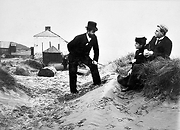 Created by James Whitehead Pattison
Donated by Bowes Museum, Barnard Castle, County Durham
Created by James Whitehead Pattison
Donated by Bowes Museum, Barnard Castle, County DurhamPart of the Pattison's Photographs collection
Dated 1888
Captain Joe Bunting (in the top hat) talking to Customs House Manager Willliam Robert Staveley (born 1839, Sussex) and his sister near Carr House cottages. Carr House & the cottages were on the edge of the cliff a little further along from The Green. They were demolished in 1904.
More detail » Carr Houses
Carr Houses
 Created by Thomas Thorpe
Donated by Bowes Museum, Barnard Castle, County Durham
Created by Thomas Thorpe
Donated by Bowes Museum, Barnard Castle, County DurhamPart of the Part of the Pattison's Photographs collection
Dated 1848
A sketch by Thomas Thorpe looking towards the buildings north of the Green. Carr House farm & cottages are depicted on the seaward side of the view. This came from Margaret Lawson's book that was in the Pattison collection.
Margaret Lawson was born in 1841 and was the daughter of John Lawson, vicar of Holy Trinity Church.
More detail » Chapel on Front Street
Chapel on Front Street
 Created by James Whitehead Pattison
Donated by Bowes Museum, Barnard Castle, County Durham
Created by James Whitehead Pattison
Donated by Bowes Museum, Barnard Castle, County DurhamPart of the Pattison's Photographs collection
Dated 1888
The barometer which stands at the side of the road was donated by the Lifeboat Commision in August 1869. Opposite the old cannon is the Wesleyan Chapel built in 1830 and enlarged in 1878. In the early years the sea was so close it would spray up against the Chapel windows.
By 1949 the chapel building was being used as a fun palace.
More detail » Chapel on Front Street (2)
Chapel on Front Street (2)
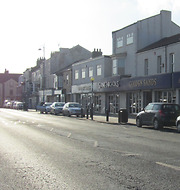 Created by Maureen Anderson
Donated by Maureen Anderson
Created by Maureen Anderson
Donated by Maureen AndersonDated 2012
Where the Chapel stood is now the Golden Sands amusement arcade. Many of the other buildings remain but most of them now with shop fronts.
More detail » Charles Street - 1961
Charles Street - 1961
 Donated by Hartlepool Museums
Donated by Hartlepool MuseumsDated 1961
In the 19th century this small street hosted Ralph Noddings' joinery and Robert Ferguson's cobbler shop. The street looks rather neglected in this image of 1961.
More detail » Charles Street - 2012
Charles Street - 2012
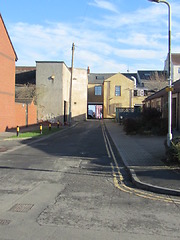 Created by Maureen Anderson
Donated by Maureen Anderson
Created by Maureen Anderson
Donated by Maureen AndersonDated 2012
In November 2012 Charles Street is hardly recognisable to the 20th century image. It is now host to elderly people's bungalows. The rear of the building and the overhang next to it leading to The Front are the only remaining structures.
More detail » Church Street
Church Street
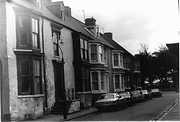 Donated by Hartlepool Library Services
Donated by Hartlepool Library ServicesPart of the Hartlepool Library collection
Dated 1977
The south side of Church Street looking towards Holy Trinity Church in 1977.
hht&n 2025
More detail » Church Street Seaton Carew
Church Street Seaton Carew
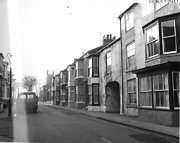 Donated by Hartlepool Library Service
Donated by Hartlepool Library ServiceChurch Street Seaton Carew. The arch is an entrance to what was once the stables and is now a car park
More detail » Church Street lodging houses
Church Street lodging houses
 Created by James Whitehead Pattison
Donated by Bowes Museum, Barnard Castle, County Durham
Created by James Whitehead Pattison
Donated by Bowes Museum, Barnard Castle, County DurhamPart of the Pattison's Photographs collection
Dated 1888
Looking towards the sea. The large houses were built in 1792 at the same time as the Seaton Hotel. They were to cater for the wealthy Quakers that frequented the village during the summer months and shared a kitchen with the hotel.
More detail » Church Street lodging houses (2)
Church Street lodging houses (2)
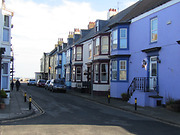 Created by Maureen Anderson
Donated by Maureen Anderson
Created by Maureen Anderson
Donated by Maureen AndersonDated 2012
Some of these large houses are still used as guesthouses as they were when built in 1792.
More detail » Church Street, Seaton Carew - 1880
Church Street, Seaton Carew - 1880
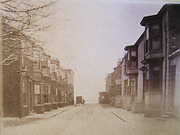 Donated by Maureen Anderson
Donated by Maureen AndersonChurch Street looking towards the sea in about 1880. Robert Proctor lived in this street and the cab is probably his as he was in the business of transporting people from the railway station to the sea front.
More detail » Corner of Church Street
Corner of Church Street
 Donated by Maureen Anderson
Donated by Maureen AndersonOn the corner of Church Street and The Front is the Waverley Cafe and Hotel. Further along is the Dunelm Cafe and then Hawkin's shop. This image would be from the 1950s.
More detail » Corner of Church Street (2)
Corner of Church Street (2)
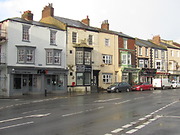 Created by Maureen Anderson
Donated by Maureen Anderson
Created by Maureen Anderson
Donated by Maureen AndersonDated 2012
In December 2012 the buildings remain as they were in the 19th century but the facades have changed. What has been the Waverly for many years has now been renamed 'Fish'. The building is in the process of renovation.
More detail » Corner of Green Terrace
Corner of Green Terrace
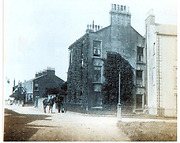 Created by James Whitehead Pattison
Donated by Bowes Museum, Barnard Castle, County Durham
Created by James Whitehead Pattison
Donated by Bowes Museum, Barnard Castle, County DurhamPart of the Pattison's Photographs collection
Dated 1888
The large house on the corner of Green Terrace and the Green in 1888. Jim Drake with his horse and dog pose for the photo.
More detail » Corner of Station Lane and The Cliff - 1920s
Corner of Station Lane and The Cliff - 1920s
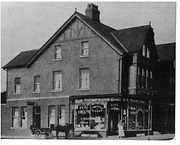 Donated by Maureen Anderson
Donated by Maureen AndersonOn the corner of Station Lane and the Cliff the house was built in 1900 and became Isaac Sparke Thompson's shop selling souvenirs, tobacco and all manner of things. It also housed a cafe and smoking room. It later became Shingfield's Groceries and Provisons. In recent years it became a second hand clothes shop and is now in 2012 a private residence.
More detail » Corner of Station Lane and The Cliff - 2005
Corner of Station Lane and The Cliff - 2005
 Created by Maureen Anderson
Donated by Maureen Anderson
Created by Maureen Anderson
Donated by Maureen AndersonDated 2005
In 2005 the building is a residential dwelling with little change to the exterior.
More detail » Corner of The Front and Church Street 2012
Corner of The Front and Church Street 2012
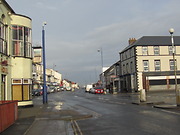 Created by Maureen Anderson
Donated by Maureen Anderson
Created by Maureen Anderson
Donated by Maureen AndersonDated 2012
December 2012 showing the changes along Seaton Front
More detail » Corner of The Front and Church Street c1900
Corner of The Front and Church Street c1900
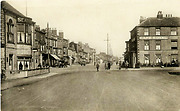 Donated by Maureen Anderson
Donated by Maureen AndersonThis image would be about 1900 and shows a 'Garage' sign on the hotel. On the fence another sign reads 'Fill up here with Shell'.
More detail » Corner of The Front and Church Street c1950
Corner of The Front and Church Street c1950
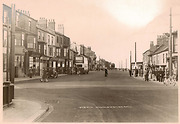 Donated by Maureen Anderson
Donated by Maureen AndersonA busy day probably in the 1950s. The Dunelm Cafe sign is on the left of the image, next door is J Hunter and then Hawkins.
More detail » Cottage on Seaton Lane
Cottage on Seaton Lane
 Created by James Whitehead Pattison
Donated by Bowes Museum, Barnard Castle, County Durham
Created by James Whitehead Pattison
Donated by Bowes Museum, Barnard Castle, County DurhamPart of the Part of the Pattison's Photographs collection
Dated 1889
A pretty white-washed cottage that stood behind the wall on what was Seaton Lane and is now Station Lane.
More detail » Cows near Lawson Road
Cows near Lawson Road
 Created by James Whitehead Pattison
Donated by Bowes Museum, Barnard Castle, County Durham
Created by James Whitehead Pattison
Donated by Bowes Museum, Barnard Castle, County DurhamPart of the Pattison's Photographs collection
Dated 1888
Pattison's house on Lawson Road. Note the Staincliffe to the back of the image. Nothing for the cows to graze on now as the whole area is built up!
More detail » East side of The Front - 1860s
East side of The Front - 1860s
 Donated by Maureen Anderson
Donated by Maureen AndersonIn this c1860s photo the small group of houses backed onto the foreshore. One cottage served as the post office and one was owned by the Vitty family. The lifeboat house and the customs house can be seen to the back of the view.
More detail » East side of The Front - 2009
East side of The Front - 2009
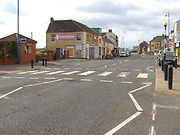 Created by Maureen Anderson
Donated by Maureen Anderson
Created by Maureen Anderson
Donated by Maureen AndersonDated 2009
Taken in 2009 this image shows the vast changes since the 19th century. The small row of cottages has been added to and all are now shops. The corner building was built in 1894 and has been a provision store, cinema and cafe over the years.
More detail » East side of The Front -1950s
East side of The Front -1950s
 Donated by Maureen Anderson
Donated by Maureen AndersonIn an image taken in the c1950s the 'Garage' sign is on the Seaton Hotel. The bandstand and the north shelter are further along from the shops.
More detail » End of the village
End of the village
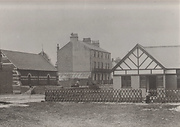 Created by James Whitehead Pattison
Donated by Bowes Museum, Barnard Castle, County Durham
Created by James Whitehead Pattison
Donated by Bowes Museum, Barnard Castle, County DurhamPart of the Part of the Pattison's Photographs collection
Dated 1888
The lifeboat house, golf clubhouse & the large building that was later to become the Southolme guest house. These buildings marked the end of the village to the south.
More detail » Flagpole
Flagpole
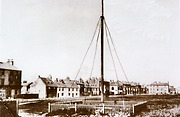 Donated by Maureen Anderson
Donated by Maureen AndersonThe white cottages on the Front to the left of the image were demolished in 1973.
More detail » Franklin's Corner (1)
Franklin's Corner (1)
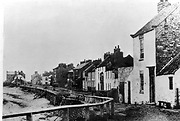 Created by Edward Backhouse
Donated by Bowes Museum, Barnard Castle, County Durham
Created by Edward Backhouse
Donated by Bowes Museum, Barnard Castle, County DurhamPart of the Pattison's Photographs collection
Dated 1853
This early image was taken by Edward Backhouse in 1853. The white building on the nearside of the view was named after the family, Franklin, who lived there. It was on the corner of what is now the Cliff with the low brick wall on the corner of what was Seaton Lane and is now Station Lane. The Seaton Hotel can be seen towards the end of the image. Note how close the houses are to the beach.
The old cannon that was brought up from the Tees was embedded in the sea-wall here for a while before it was moved to the grass verge where it can be seen in other photos.
More detail » Franklin's Corner (2)
Franklin's Corner (2)
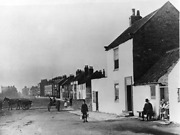 Created by James Whitehead Pattison
Donated by Bowes Museum, Barnard Castle, County Durham
Created by James Whitehead Pattison
Donated by Bowes Museum, Barnard Castle, County DurhamPart of the Pattison's Photographs collection
Dated 1889
Thirty six years on from the previous image the road has been widened and a grass verge put in place. The horse and cart are heading down the slipway opposite Station (Seaton) Lane probably to collect sea coal from the beach.
More detail » Franklin's Corner (3)
Franklin's Corner (3)
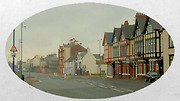 Created by Maureen Anderson
Donated by Maureen Anderson
Created by Maureen Anderson
Donated by Maureen AndersonDated 2007
Taken in 2003 this shows the changes since 1853 and 1889. Tudor style buildings have replaced Franklin's house. On the opposite side of Station Lane the farmhouse has gone and the Marine Hotel has replaced the small Seven Stars inn.
More detail » Franklin's Corner (4)
Franklin's Corner (4)
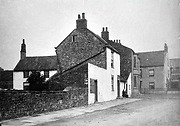 Created by James Whitehead Pattison
Donated by Bowes Museum, Barnard Castle, County Durham
Created by James Whitehead Pattison
Donated by Bowes Museum, Barnard Castle, County DurhamPart of the Part of the Pattison's Photographs collection
Dated 1889
The white-washed buildings were named for the Franklin's who lived there. The wall swept round to what is now Station Lane. The house that appears side-on in the view still remains today.
More detail » Franklin's Corner (5)
Franklin's Corner (5)
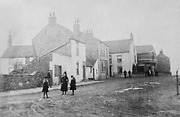 Created by James Whitehead Pattison
Donated by Bowes Museum, Barnard Castle, County Durham
Created by James Whitehead Pattison
Donated by Bowes Museum, Barnard Castle, County DurhamPart of the Part of the Pattison's Photographs collection
Dated 1889
Children gather on what was no more than a dirt track outside the house that belonged to the Franklin's.
More detail » Franklin's Corner (6)
Franklin's Corner (6)
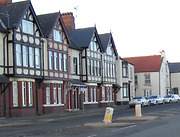 Created by Maureen Anderson
Donated by Maureen Anderson
Created by Maureen Anderson
Donated by Maureen AndersonDated 2012
The white-washed cottages owned by the Franklin's were demolished to make way for a row of mock Tudor buildings in 1900.
More detail » From the Snooks
From the Snooks
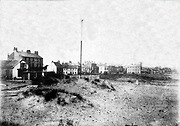 Donated by Maureen Anderson
Donated by Maureen AndersonTaken in the early 1880s to the right of the image is a shack that was lived in by one of the cockle gatherers and next to that is the Customs House. The flagpole is in the centre of the image and the Cafe Royal can be seen further on.
More detail » Golf Club house
Golf Club house
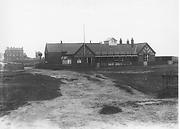 Donated by Hartlepool Library Service
Donated by Hartlepool Library ServiceSeaton Golf Club, Club House, Not known when picture was taken but the bus station, which was built in the 1938, is not there.
HHT&N 985
More detail » House on Church Street Seaton Carew
House on Church Street Seaton Carew
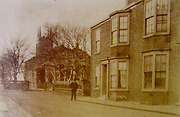 Created by James Whitehead Pattison
Donated by Bowes Museum, Barnard Castle, County Durham
Created by James Whitehead Pattison
Donated by Bowes Museum, Barnard Castle, County DurhamPart of the Pattison's Photographs collection
Dated 1888
The first house was lived in by James Pattison when he first became curate of Holy Trinity Church in 1885. Many of his photos are the only record of Seaton Carew as it was between 1885 and 1890.
More detail » Houses and Seaton Hotel - c1870
Houses and Seaton Hotel - c1870
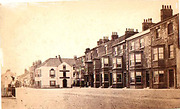 Donated by Maureen Anderson
Donated by Maureen AndersonThe row of houses was built in the 1820's with many taking in visitors during the summer season. This image is c1870.
More detail » Houses and Seaton Hotel - 2005
Houses and Seaton Hotel - 2005
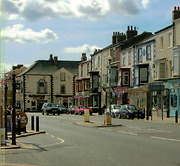 Created by Maureen Anderson
Donated by Maureen Anderson
Created by Maureen Anderson
Donated by Maureen AndersonDated 2005
The row of houses are now all in use as variuous types of shops. Taken in August 2005 bunting bedecks the shop fronts to celebrate the 60th anniversary of V.E. Day. 30 The Front has a large teapot painted between its upper windows from the time when it was the Victoria Tearooms (early 1990s)
More detail » Houses and Seaton Hotel - 2012
Houses and Seaton Hotel - 2012
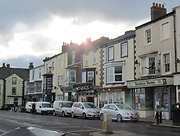 Created by Maureen Anderson
Donated by Maureen Anderson
Created by Maureen Anderson
Donated by Maureen AndersonDated 2012
In November 2012 the buildings have all had a face lift and are looking quite fresh and tidy.
More detail » In front of the Low Light
In front of the Low Light
 Created by James Whitehead Pattison
Donated by Bowes Museum, Barnard Castle, County Durham
Created by James Whitehead Pattison
Donated by Bowes Museum, Barnard Castle, County DurhamPart of the Pattison's Photographs collection
Dated 1888
Cooper and his two friends play in a pool on the beach. Staincliffe Villa and the lowlight stand above them.
More detail » Kirklea, Church Street (1)
Kirklea, Church Street (1)
 Donated by Maureen Anderson
Donated by Maureen AndersonThis image of about 1900 of 'Kirklea' number 7 Church Street is of one of the attendant lodging houses to the Seaton Hotel built in 1792. In the cellar there is the imprint of where a large wood burning range once stood. The small building adjoining the house was once a blacksmith shop. In 1843 the title deeds were in the names of The Honourable Augusta Powlett, George Hutton Wilkinson, Octavius Hutton Wilkinson and Reverend John Lawson. In 1949 the owners were Mr and Mrs F.C. Fudge.
More detail » Kirklea, Church Street (2)
Kirklea, Church Street (2)
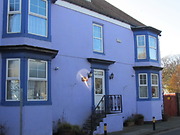 Created by Maureen Anderson
Donated by Maureen Anderson
Created by Maureen Anderson
Donated by Maureen AndersonDated 2012
According to the title deeds the house that is now number 7 Church Street has been known as 'Kirklea' or 'Kirk Lea' since at least 1843. This image is November 2012. The small building adjoining was demolished long ago to make way for a driveway and the bright colours show that the taste in house decor has changed considerably.
More detail » Lawson Road
Lawson Road
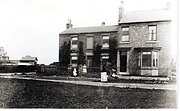 Created by James Whitehead Pattison
Donated by Bowes Museum, Barnard Castle, County Durham
Created by James Whitehead Pattison
Donated by Bowes Museum, Barnard Castle, County DurhamPart of the Pattison's Photographs collection
Dated 1888
James Pattison and his family eventually moved to this house from Church Street and lived here until 1890. Note Staincliffe House to the far left of the image. The house still stands and is on the corner of Queen Street and Lawson Road.
More detail » Lifeboat house and Golf clubhouse
Lifeboat house and Golf clubhouse
 Created by James Whitehead Pattison
Donated by Bowes Museum, Barnard Castle, County Durham
Created by James Whitehead Pattison
Donated by Bowes Museum, Barnard Castle, County DurhamPart of the Pattison's Photographs collection
Dated 1888
The lifeboat house is on the extreme left with the golf clubhouse opposite. The customs house stands behind the clubhouse and just opposite is a wooden structure which was lived in by Bella, one of the cockle girls.
More detail » Longscar Hall
Longscar Hall
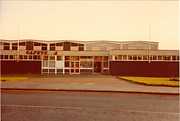 Donated by Hartlepool Library Services
Donated by Hartlepool Library ServicesPart of the Hartlepool Library collection
Built in May 1967 the hall, originally run as a fairly successful catering and event venue by Hartlepool Corporation, has caused controversy since the day it was erected.
It was sold by the council to a private company and greatly remodelled in 1989, renamed Coasters and opened as a pub and nightclub but then became derelict and remained so for a number of years and was a serious eyesore. The rebuilt structure still remains and is a subject of controversy in local politics (2016) It was seriously further damaged in a 2018 fire.
Update : the building has finally been demolished in May 2019.
hht&n2016
More detail » Looking south along the beach
Looking south along the beach
 Created by Thomas Thorpe
Donated by Maureen Anderson
Created by Thomas Thorpe
Donated by Maureen AndersonDated 1848
From an etching in 1848 by Thomas Thorpe of Darlington. Thomas tried to sell his work in Hartlepool & Seaton but having no success he returned to Darlington.
Carr Houses can be seen on top of the cliff overlooking the beach.
I believe Hartlepool Museums have the original of this work in their collection.
More detail » Looking south from Franklin's Corner
Looking south from Franklin's Corner
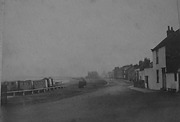 Donated by Maureen Anderson
Donated by Maureen AndersonLooking south past the wall that was on the corner of Seaton (Station) Lane towards the Seaton Hotel and the lifeboat house at the end of the view. This image is prior to the sea wall being constructed and the road widened so probably early 1880s. The bathing machines appear to be stored away for the winter.
More detail » North Road - 1887
North Road - 1887
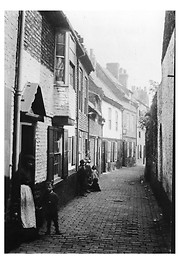 Created by James Whitehead Pattison
Donated by Bowes Museum, Barnard Castle, County Durham
Created by James Whitehead Pattison
Donated by Bowes Museum, Barnard Castle, County DurhamPart of the Pattison's Photographs collection
Dated 1887
Taken in 1887 the image shows the cobbled surface of the small road that runs off The Green.
More detail » North Road - 1979
North Road - 1979
 Donated by Douglas RP Ferriday
Donated by Douglas RP FerridayPart of the Hartlepool Library collection
Dated 1979
By the time of this photo in 1979 there are no houses remaining at the entrance to the road and the cobbles have been covered by tarmac. The cobbles can still be seen to the sides of the road.
hht&n 2017
More detail » North Road - 2009
North Road - 2009
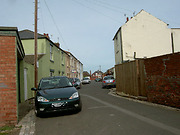 Created by Maureen Anderson
Donated by Maureen Anderson
Created by Maureen Anderson
Donated by Maureen AndersonDated 2009
By 2009 the street is looking a lot tidier and is now full of cars. When on the road the original cobbles can still be seen at the side under the tarmac.
More detail » Old cottage on Green Terrace
Old cottage on Green Terrace
 Created by Maureen Anderson
Donated by Maureen Anderson
Created by Maureen Anderson
Donated by Maureen AndersonDated 2000
This cottage was in such a bad state of repair that it was earmarked for demolition. Ian Christison & his wife purchased the property for £10,000 & proceeded on restoration which took over four years to complete. Fragments of pottery were found on the site & passed to a Durham archaeologist who visited the property. After intense investigation it was eventually concluded that this had originally been a fourteenth century dwelling with living quarters upstairs & livestock kept below. It was recorded as being the 'oldest lived-in dwelling in Cleveland' & became a listed building.
More detail » Old cottages and house
Old cottages and house
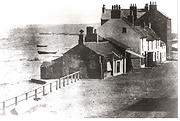 Created by Edward Backhouse
Donated by Bowes Museum, Barnard Castle, County Durham
Created by Edward Backhouse
Donated by Bowes Museum, Barnard Castle, County DurhamPart of the Pattison's Photographs collection
Dated 1853
The photo taken in 1853 shows the little row of buildings that back onto the foreshore. They would have probably been flooded at extremely high tides. The centre cottage was a post office and grocery shop. The large house at the end was a farmhouse and then became the Cafe Royal.
More detail » Old cottages and house (2)
Old cottages and house (2)
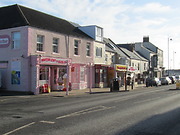 Created by Maureen Anderson
Donated by Maureen Anderson
Created by Maureen Anderson
Donated by Maureen AndersonDated 2012
November 2012 showing that some of the old buildings that were in the 1853 image remain. The additional building to the front of the image was built in 1894.
More detail » Old view of Carr Houses
Old view of Carr Houses
 Donated by Bowes Museum, Barnard Castle, County Durham
Donated by Bowes Museum, Barnard Castle, County DurhamPart of the Pattison's Photographs collection
Dated 1866
A wonderful old photo of Carr Houses and cottages and the steps to the beach in April 1866. This would have given a good vantage point for ships being wrecked or stranded on Longscar Rocks. The cottages were demolished in 1904 and Carr House in 1925. Eventually the cliff was levelled & improvements made between the Green and the beach.
More detail » Presentation in Longscar Hall
Presentation in Longscar Hall
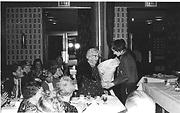 Donated by Anne Cox
Donated by Anne CoxDated 1973
The photo was taken in 1973 inside Longscar Hall. The 40th Scouts group scoutmaster was Lloyd Taylor, and here his mother is being presented with flowers to celebrate the 40th anniversary of the 40th Scouts.
This original Longscar Hall had a concertina partition half way across the hall which created two smaller halls. This can be seen behind Mrs Taylor. The partition was opened for large events, as this must have been, and on exceptionally busy summer days at Seaton when there were also doors which opened onto the sea side of the building.
More detail » Road along the cliff top
Road along the cliff top
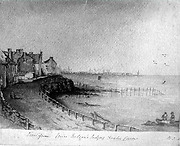 Created by Miss Nelson
Donated by Bowes Museum, Barnard Castle, County Durham
Created by Miss Nelson
Donated by Bowes Museum, Barnard Castle, County DurhamPart of the Part of the Pattison's Photographs collection
A sketch entitled 'View from Miss Nelson's lodging.' This sketch would be from the 1840's when only a dirt track wound its way along the cliff top. Hartlepool can be seen in the distance
More detail » Road to the Golf Links
Road to the Golf Links
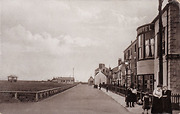 Donated by Maureen Anderson
Donated by Maureen AndersonLooking south the lifeboat house is at the end of the village with the golf club-house on the right partially hidden by the Custom's House. A hand-cart sits outside a cottage on the left & children & two women are on the footpath outside the Seaton Hotel. This photo would have been taken in the 1880s
More detail » Rocket House
Rocket House
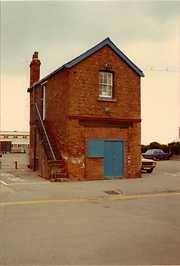 Donated by Hartlepool Library Services
Donated by Hartlepool Library ServicesPart of the Hartlepool Library collection
The building was originally erected to store the equipment needed to save life at sea by the means of rocket lines. It saw service as a part time police station around the 1980s and was being used as a first aid post when this photo was taken. Longscar Hall can be seen to the rear.
hht&n 2039
More detail » Seaton Lane (5)
Seaton Lane (5)
 Donated by Hartlepool Library Services
Donated by Hartlepool Library ServicesPart of the Hartlepool Library collection
Dated 1963
Seaton Lane from Brenda Road after the road widening. Golden Flatts School on left.
hht&n 2027
More detail » Seaton Carew 1861
Seaton Carew 1861
 Donated by Hartlepool Museum Service
Donated by Hartlepool Museum ServiceCarr House on the Cliff above Carr House sands (almost opposite the green) House now gone and Cliff leveled off.
More detail » Seaton Carew Branch Library
Seaton Carew Branch Library
 Donated by Hartlepool Library Service
Donated by Hartlepool Library ServiceDated 1970
A rarely seen inside view of the Library in 1970. Note the ashtrays on the table - how times have changed!
More detail » Seaton Carew then and now
Seaton Carew then and now
 Created by Bill Stevenson
Donated by Hartlepool Library Service
Created by Bill Stevenson
Donated by Hartlepool Library ServiceSeaton Carew, Hartlepool. Stationary corporation bus going to West Hartlepool outside of what is now the Norton Hotel
More detail » Seaton Front 1966
Seaton Front 1966
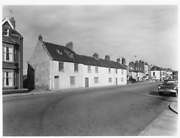 Donated by Douglas Ferriday
Donated by Douglas FerridayPart of the Hartlepool Library Service collection
Picture showing old cottages which have now been demolished. They were on The Front towards the south end of Seaton. In their place is Crawford Street and Seymour House.
HHT&N 83
More detail » Seaton Front prior to 1900
Seaton Front prior to 1900
 Donated by Hartlepool Museum Service
Donated by Hartlepool Museum ServiceSeaton Front prior to 1900. Note how close the beach is to the road. The Seven Stars PH is in the centre of the picture. This was demolished and The Marine Hotel built on the land in 1900.
More detail » Seaton Lane
Seaton Lane
 Donated by Mike Oxley
Donated by Mike OxleyPart of the Valentine Series collection
Dated 1900
Seaton Lane, later to be known as Station Lane, Seaton Carew, Hartlepool taken from a postcard from a series dated 1900.
More detail » Seaton Lane
Seaton Lane
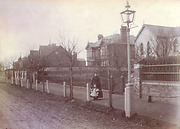 Created by James Whitehead Pattison
Donated by Bowes Museum, Barnard Castle, County Durham
Created by James Whitehead Pattison
Donated by Bowes Museum, Barnard Castle, County DurhamPart of the Pattison's Photographs collection
Dated 1888
A very well dressed Queeny Trechmann with her nanny in Seaton Lane in 1888. The nanny is probably Mary Jane Boyd who was the nursery governess to Otto Trechmann's children at this time. The house with the small balcony eventually became Dinsdale Lodge Nursing Home.
More detail » Seaton Lane (1)
Seaton Lane (1)
 Created by James Whitehead Pattison
Donated by Hartlepool Library Service
Created by James Whitehead Pattison
Donated by Hartlepool Library ServiceDated 1888
Seaton Lane, Seaton Carew in 1888. The twin peaked house belonged to the Hogg family. Mr Hogg was a ships' underwriter. The house was eventually named The Gables and became a guest house & later a nursing home. Next door was Ivycroft which became Seaton Carew Social Club and further along was Dinsdale Lodge which also became a nursing home.
More detail » Seaton Lane (2)
Seaton Lane (2)
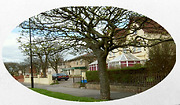 Created by Maureen Anderson
Donated by Maureen Anderson
Created by Maureen Anderson
Donated by Maureen AndersonDated 2008
Station Lane in 2008. The twin peaked house built by the Hogg family became the Gables Guesthouse and at the time of this photo had become Parkview Nursing Home with conservatories built to the front. The Purvis family owned it for many years. The house next door, Ivycroft, is the Seaton Carew Social Club and further along Dinsdale Lodge has also been converted into a nursing home.
Update: Parkview Nursing Home closed because of a tragic incident. The conservatories were removed and the building left to go to ruin. In 2020 it stands empty and neglected.
More detail » Seaton Lane (3)
Seaton Lane (3)
 Donated by Hartlepool Library Services
Donated by Hartlepool Library ServicesPart of the Hartlepool Library collection
Dated 1962
Seaton Lane looking east during road widening in 1962. Golden Flatts School on right
hht&n 2047
More detail » Seaton Lane (4)
Seaton Lane (4)
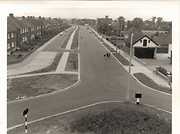 Donated by Hartlepool Library Services
Donated by Hartlepool Library ServicesPart of the Hartlepool Library collection
Dated 1963
 Seaton Lane 1960
Seaton Lane 1960
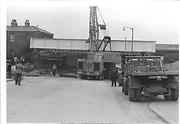 Donated by Hartlepool Library Service
Donated by Hartlepool Library ServiceDated 1960
Taken in September 1960, a girder is being placed in position for the railway bridge as the road is widened. This is probably looking east towards Seaton ?
More detail » Seaton Lane and farmhouse
Seaton Lane and farmhouse
 Created by James Whitehead Pattison
Donated by Bowes Museum, Barnard Castle, County Durham
Created by James Whitehead Pattison
Donated by Bowes Museum, Barnard Castle, County DurhamPart of the Pattison's Photographs collection
Dated 1888
Seaton Lane when it was still little more than a dirt road. Boddy's farmhouse on the end corner was demolished after World War 1 and the farm is now the site of the Seaton Carew Library and the Park.
More detail » Seaton Low Light (1)
Seaton Low Light (1)
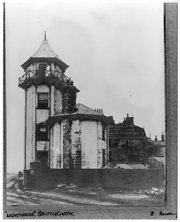 Donated by Hartlepool Museum Service
Donated by Hartlepool Museum ServiceThe Lighthouse was built in 1838/39 on the Cliff above Longscar Rocks. Another lighthouse was erected at the same time at Longhill. Seaton light was known as the lowlight and the Longhill light was known as the highlight. From out at sea one light would shine above the other, warning the mariners of the dangers of the rocks.
More detail » Seaton Low Light (2)
Seaton Low Light (2)
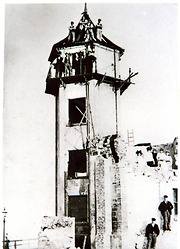 Donated by Douglas Ferriday
Donated by Douglas FerridayPart of the Hartlepool Library Service collection
This image shows the demolition of the lighthouse in 1900. There are certainly no health and safety regulations in place here. Note that there are even five females posing behind the demolished brickwork.
HHT&N 598
More detail » Seaton old light
Seaton old light
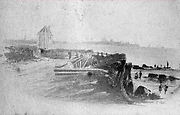 Created by Thomas Thorpe
Donated by Bowes Museum, Barnard Castle, County Durham
Created by Thomas Thorpe
Donated by Bowes Museum, Barnard Castle, County DurhamPart of the Part of the Pattison's Photograph Collection collection
Dated 1848
A sketch entitled 'Seaton old light and sand pit' by Thomas Thorpe was in Margaret Lawson's book that was in Pattison's collection.
More detail » Shop and cottages on The Front
Shop and cottages on The Front
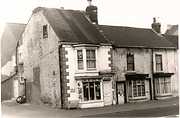 Donated by Hartlepool Library Services
Donated by Hartlepool Library ServicesPart of the Hartlepool Library collection
Dated 1977
Numbers 73, 74 and 75 The Front in September 1977. The shop is advertising Take Out Coffee Shop and Candy Floss in Bags. The buildings next door were residential at this time and in a very poor state of repair.
hht&n 2002
More detail » Sketch of Seaton Carew 1848
Sketch of Seaton Carew 1848
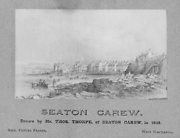 Created by Thomas Thorpe
Donated by Hartlepool Museum Service
Created by Thomas Thorpe
Donated by Hartlepool Museum ServiceSketch of Seaton Carew drawn in 1848 by Thomas Thorpe of Darlington.
More detail » South end of Seaton Carew - 1860s
South end of Seaton Carew - 1860s
 Donated by Maureen Anderson
Donated by Maureen AndersonThis image is c1860 and the lifeboat house marked the end of the village until it was moved in 1914 when POWs constructed the Port Clarence road. The large house at the end of the row was, at this time, two separate residences. It later became a guest house named the Southolme and then the Arches. The white cottages towards the end of the row were demolished in 1973. The sixth house along was known as Bath House and in 1838 the title deeds were in the names of Thomas Crawford, Ralph Ward Jackson and William Wood. The house was occupied by Thomas Crawford, yeoman, and his family. The Crawfords were related to the Hood family, lifeboat men.
More detail » South end of Seaton Carew - 2005
South end of Seaton Carew - 2005
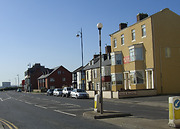 Created by Maureen Anderson
Donated by Maureen Anderson
Created by Maureen Anderson
Donated by Maureen AndersonDated 2005
This photo taken in 2005 shows a car park entrance where there was once a large residential dwelling between the Seaton Hotel and the Durham Hotel. Seymour House, a modern building stands where there had been cottages which were demolished in 1973.
More detail » Southend Houses
Southend Houses
 Donated by Hartlepool Library Services
Donated by Hartlepool Library ServicesPart of the Hartlepool Library collection
Probably taken in the 1980s the house to the left of the image was built in 1809. It was known as the Lifeboat House probably because equipment for the boat would have been stored there prior to a custom made boathouse being built. The two cottages were built about 1770 with one used as a blacksmiths in the 1880s run by Christopher Bell.
hht&n 2026
More detail » Southend Houses (2)
Southend Houses (2)
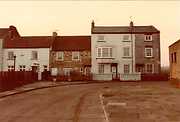 Donated by Hartlepool Library Services
Donated by Hartlepool Library ServicesPart of the Hartlepool Library collection
The two large dwellings at the end were originally one large house and would pre-date the next door cottages built about 1770. It is thought that the large house was used by Lord John Eldon in the summer months during the 19th century.
hht&n 2024
More detail » Southend Houses (3)
Southend Houses (3)
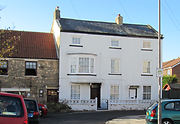 Created by Maureen Anderson
Donated by Maureen Anderson
Created by Maureen Anderson
Donated by Maureen AndersonDated 2012
A view of the Southend Houses in 2012.
More detail » Staincliffe House
Staincliffe House
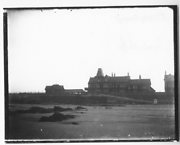 Part of the Hartlepool Museum Service collection
Part of the Hartlepool Museum Service collectionBuilt in 1869 as a private residence for Thomas Walker. This photo was taken from the beach.
More detail » Staincliffe House
Staincliffe House
 Donated by Hartlepool Museum Service
Donated by Hartlepool Museum ServiceThe Staincliffe, Seaton Carew whilst it was still a private dwelling.
More detail » Staincliffe House 2
Staincliffe House 2
 Part of the Hartlepool Museum Service collection
Part of the Hartlepool Museum Service collectionTaken when still a private residence, Staincliffe Villas and the lighthouse can be seen to the right.
More detail » Staincliffe House conservatory
Staincliffe House conservatory
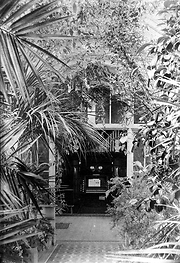 Created by James Whitehead Pattison
Donated by Bowes Museum, Barnard Castle, County Durham
Created by James Whitehead Pattison
Donated by Bowes Museum, Barnard Castle, County DurhamPart of the Part of the Pattison's Photographs collection
Dated 1888
Lush tropical plants frame an organ in the conservatory/greenhouse of Staincliffe House.
More detail » Staincliffe Villas
Staincliffe Villas
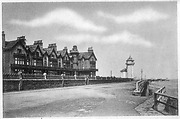 Created by Unknown
Donated by Maureen Anderson
Created by Unknown
Donated by Maureen AndersonThe villas were built about 1869 by Thomas Walker next to his house. The lowlight stands on the sea side of the track.
More detail » Staincliffe Villas (3)
Staincliffe Villas (3)
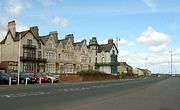 Created by Maureen Anderson
Donated by Maureen Anderson
Created by Maureen Anderson
Donated by Maureen AndersonDated 2005
In 2005 the villas have not changed much since they were built in about 1869. The surrounding area has changed beyond all recognition. The original wall has gone and where there was once no more than a dirt track there is now a road.
More detail » Staincliffe and villas - 1888
Staincliffe and villas - 1888
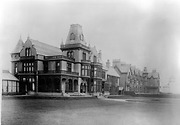 Created by James Whitehead Pattison
Donated by Bowes Museum, Barnard Castle, County Durham
Created by James Whitehead Pattison
Donated by Bowes Museum, Barnard Castle, County DurhamPart of the Pattison's Photographs collection
Dated 1888
Staincliffe House and the adjoining villas were built by Thomas Walker in 1869. He had a sawmill, established in 1851, in Mainsforth Terrace employing 200 men. The house was bought by William Gray in 1921 as a convallescent home for his workers. By 1929 it was owned by TW Pinkney and was in use as a country club, although not licensed to sell alchohol, then, during WW2 it was taken over by the army. In the very early 1940s it was taken over by Vaux Breweries and converted to a hotel and became licenced. Note the low light to the back of the image.
More detail » Staincliffe villas (2)
Staincliffe villas (2)
 Created by James Whitehead Pattison
Donated by Bowes Museum, Barnard Castle, County Durham
Created by James Whitehead Pattison
Donated by Bowes Museum, Barnard Castle, County DurhamPart of the Pattison's Photographs collection
Dated 1888
J Hogg and S Simpson posing in front of the villas. These buildings became big news when John Darwin faked his own death in 2002 and then reappeared alive and well in 2007. He and his wife had lived in one of these buildings and owned one next door in which Darwin hid after his 'death' until he could make his getaway.
More detail » Station Lane (1)
Station Lane (1)
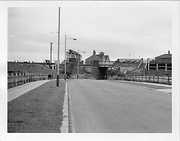 Donated by Hartlepool Library Services
Donated by Hartlepool Library ServicesPart of the Hartlepool Library collection
Dated 1958
Looking towards the railway bridge at Seaton Carew before the road widening of Station Lane.
More detail » Station Lane (2)
Station Lane (2)
 Donated by Hartlepool Library Services
Donated by Hartlepool Library ServicesPart of the Hartlepool Library collection
Dated 1960
 Station Lane and Queen Terrace - 1930s
Station Lane and Queen Terrace - 1930s
 Donated by Maureen Anderson
Donated by Maureen AndersonTo the right of the image is Boddy's farmhouse. Hay can be seen in the field. In WW1 a bomb landed in the yard of the farmouse killing a lot of chickens.
More detail » Station Lane and Queen Terrace - 2005
Station Lane and Queen Terrace - 2005
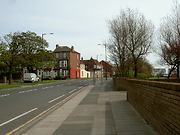 Created by Maureen Anderson
Donated by Maureen Anderson
Created by Maureen Anderson
Donated by Maureen AndersonDated 2005
In April 2005 the houses remain towards the seaward end of Station Lane. Boddy's farmhouse has gone and there is now a branch library and a park on the land.
More detail » The Cliff - Seaton Carew
The Cliff - Seaton Carew
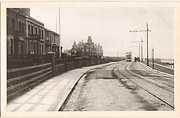 Donated by Hartlepool Library Services
Donated by Hartlepool Library ServicesPart of the Hartlepool Library collection
Dated 1906
Looking towards the Staincliffe in 1906 along what is now known as The Cliff. A tram trundles along almost side by side with a horse and cart.
More detail » The Cliff and Staincliffe - 2012
The Cliff and Staincliffe - 2012
 Created by Maureen Anderson
Donated by Maureen Anderson
Created by Maureen Anderson
Donated by Maureen AndersonDated 2012
In December 2012 the road past the Staincliffe is completely different to the 19th and early 20th centuries although a row of the original houses remain.
More detail » The Cliff and Staincliffe - c1880
The Cliff and Staincliffe - c1880
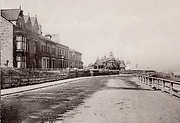 Donated by Maureen Anderson
Donated by Maureen AndersonProbably about 1880 this image shows the old sea wall and the relatively narrow roadway that was in place at the time. The houses were built for wealthy merchants who did not want to live in the hustle and bustle of Hartlepool and West Hartlepool. The Seaton low light can be seen at the back of the view.
More detail » The Cliff looking north (1)
The Cliff looking north (1)
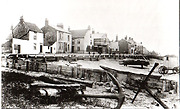 Created by James Whitehead Pattison
Donated by Bowes Museum, Barnard Castle, County Durham
Created by James Whitehead Pattison
Donated by Bowes Museum, Barnard Castle, County DurhamPart of the Pattison's Photographs collection
Dated 1889
Looking north along the Cliff, Staincliffe House can be seen in the distance, a little nearer is the large building on the north-east corner of the Green, now the Norton Hotel. A bathing machine sits on the beach. The anchors, including an 17th century wood stob, lie waiting to be used.
More detail » The Cliff looking north (2)
The Cliff looking north (2)
 Created by Maureen Anderson
Donated by Maureen Anderson
Created by Maureen Anderson
Donated by Maureen AndersonDated 2009
A similar view of the Cliff in 2009 showing the changes that had taken place over 100 years.
More detail » The Front
The Front
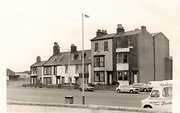 Donated by Hartlepool Library Services
Donated by Hartlepool Library ServicesPart of the Hartlepool Library collection
At the southern end of the village the building numbers 38 to 42 The Front. Numbers 38 and 39 became the Durham Hotel. In the gap at the end of the row are caravans in a field. The area was later built up with houses.
More detail » The Front
The Front
 Donated by Hartlepool Library Services
Donated by Hartlepool Library ServicesPart of the Hartlepool Library collection
Probably taken in the 1980s this shows the buildings at numbers 39 to 42 The Front at the southern end of the village.
More detail » The Front
The Front
 Donated by Hartlepool Library Services
Donated by Hartlepool Library ServicesPart of the Hartlepool Library collection
Looking south along The Front probably in the early 1980s. Note the large advertisment for Embassy cigarettes in the Marine Hotel car park.
More detail » The Front - Seaton Carew (1)
The Front - Seaton Carew (1)
 Donated by Hartlepool Library Service
Donated by Hartlepool Library ServiceDated 1966
The Front at Seaton Carew in 1966 - note the aerials rather than satellite dishes!
More detail » The Front Seaton Carew
The Front Seaton Carew
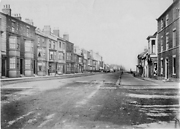 Donated by Hartlepool Museum Service
Donated by Hartlepool Museum ServiceThe Front, Seaton Carew pre 1900 as the Marine Hotel has not yet been built.
More detail » The Front Seaton Carew then and now
The Front Seaton Carew then and now
 Created by Bill Stevenson
Donated by Hartlepool Library Service
Created by Bill Stevenson
Donated by Hartlepool Library ServiceThe Front Seaton Carew with the Marine Hotel in the picture
More detail » The Front from the Common
The Front from the Common
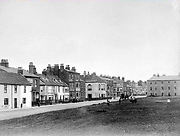 Created by Unknown
Donated by Maureen Anderson
Created by Unknown
Donated by Maureen AndersonTaken from the grass common in front of what became the Cafe Royal. On the opposite side of the road are the cottages that were demolished in 1973, private houses. Then the building that became the Durham Hotel next door to the Seaton Hotel.
More detail » The Front looking north - 1880s
The Front looking north - 1880s
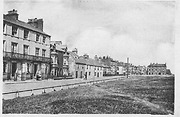 Donated by Maureen Anderson
Donated by Maureen AndersonThe large building to the left of the image started out as private dwellings. It became the Southolme guest house & then the Arches before eventaully being turned into flats. Note the iron railings to the balcony.
More detail » The Front looking north - 2012
The Front looking north - 2012
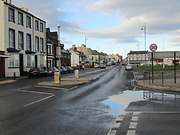 Created by Maureen Anderson
Donated by Maureen Anderson
Created by Maureen Anderson
Donated by Maureen AndersonDated 2012
In November 2012 nothing much has changed over the last few years except that the paintwork has been freshened up on the buildings.
More detail » The Front looking south
The Front looking south
 Donated by Maureen Anderson
Donated by Maureen AndersonTaken about 1895 to the left of the image is White's Cafe. On the right is the Seven Stars Inn which gave way to the Marine Hotel.
hhn&n 2048
More detail » The Front looking south
The Front looking south
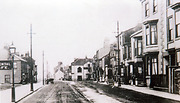 Donated by Maureen Anderson
Donated by Maureen AndersonWhite's Cafe has now become the Oriental Cafe and there are tramlines in the road dating the image to betwwen 1903 and 1927.
More detail » The Green
The Green
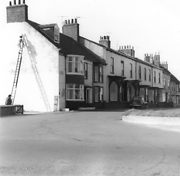 Created by Bill Boagey
Donated by Hartlepool Museum Service
Created by Bill Boagey
Donated by Hartlepool Museum ServicePart of the Bill Boagey collection
The Gable end of a house being painted on The Green, Seaton Carew.
More detail » The Green
The Green
 Donated by Hartlepool Museum Service
Donated by Hartlepool Museum ServicePart of the Stonefield Series collection
A postcard of the Green in the early 20th century showing the large ivy covered house on the corner of Green Terrace.These buildings have all survived.
More detail » The Parade, Seaton Carew
The Parade, Seaton Carew
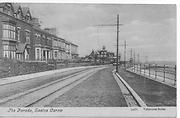 Donated by Mike Oxley
Donated by Mike OxleyPart of the Valentine Series collection
The Parade, Seaton Carew, Hartlepool. Taken from a postcard around 100 years old. Probably about 1903. We now know it as The Cliff
More detail » The Southolme Hotel
The Southolme Hotel
 Donated by Hartlepool Library Service
Donated by Hartlepool Library ServiceThe Southolme Hotel, The Front Seaton Carew. Premises still exist but are now flats.
More detail » Thomasina Burdon's cottage
Thomasina Burdon's cottage
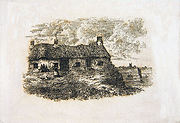 Created by Mrs S Robson
Donated by Maureen Anderson
Created by Mrs S Robson
Donated by Maureen AndersonDated 1817
An etching of a thatched cottage on the cliff at Seaton Carew. St Hilda's Church can be seen in the background. The illustration is of 'Thomasina Burdon's cottage' by Mrs S Robson from a little book entitled 'Hartlepool and Seaton' which Edward Robson of Darlington compiled for his nephews in 1817.
More detail » Tram on The Front
Tram on The Front
 Donated by Maureen Anderson
Donated by Maureen AndersonThe tram terminus was at the Seaton Hotel and became known as Kelly's Corner because of the congestion caused with passengers embarking and disembarking.
More detail » Victorian dining room - 1888
Victorian dining room - 1888
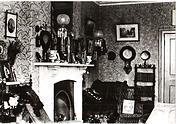 Created by James Whitehead Pattison
Donated by Bowes Museum, Barnard Castle, County Durham
Created by James Whitehead Pattison
Donated by Bowes Museum, Barnard Castle, County DurhamPart of the Pattison's Photographs collection
Dated 1888
The dining room in James Pattison's house in typical Victorian style. Lots of knick knacks and heavily patterned wallpaper.
More detail » Victorian dining room - 1888
Victorian dining room - 1888
 Created by James Whitehead Pattison
Donated by Hartlepool Museum Service
Created by James Whitehead Pattison
Donated by Hartlepool Museum ServiceDated 1888
Dining room in James Pattison's House in Lawson Road
More detail » Waverley Cafe Seaton Carew
Waverley Cafe Seaton Carew
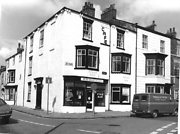 Donated by Hartlepool Library Service
Donated by Hartlepool Library ServiceThe Waverley Cafe on the corner of Church Street and The Front, Seaton Carew.
More detail » Windmills
Windmills
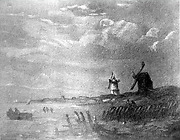 Created by Unknown
Donated by Maureen Anderson
Created by Unknown
Donated by Maureen AndersonA sketch of two windmills in the 19th century. One was Mr Lee's mill which stood in Mill Lane which then became Villiers Street. The other was was on the sea banks at Seaton Carew where Newburn Bridge is now.
More detail »



